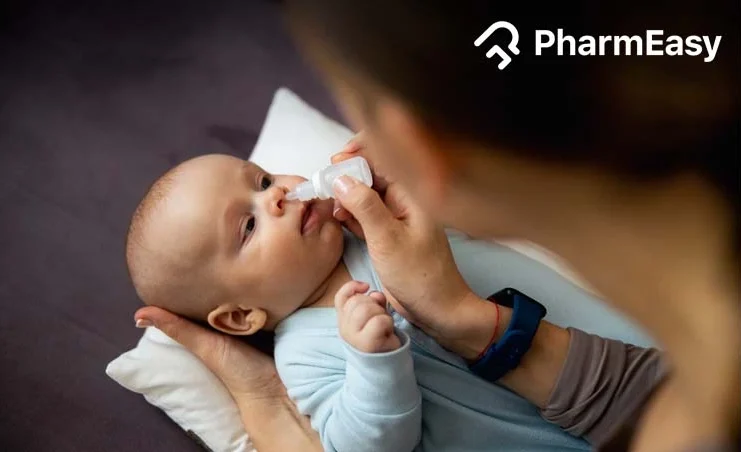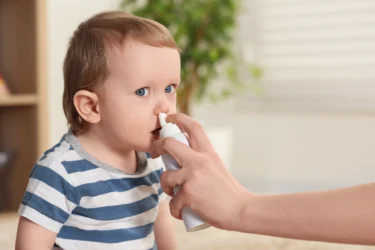Introduction
The nasal airway plays a vital role in both breathing and smell. In addition to allowing respiration, the nose and sinuses (air-filled spaces around the nose) help condition inhaled air by humidifying and filtering it, while also trapping harmful particles1.
This natural defence system is especially important in newborns, who rely mainly on nasal breathing during their first few months of life. Any obstruction of the nasal passages at this stage can therefore lead to significant issues, including breathing difficulty, sleep disturbances, feeding problems, and a higher risk of conditions such as obstructive apnoea1.
In infants and children, nasal obstruction and a runny nose are most commonly caused by viral upper respiratory tract infections (URTIs), allergic reactions, or neonatal rhinitis. Since babies cannot blow their noses effectively, the accumulation of mucus can worsen discomfort and respiratory distress1,2.
To relieve this, nasal drops or sprays are commonly recommended1,2.They are safe, gentle, and effective in easing congestion, but their correct and careful use is essential. Therefore, through this guide, we aim to help parents understand the different types of nasal drops available for babies, their uses, and important safety tips.
What Are Nasal Drops and Sprays?
Nasal drops or sprays are liquid formulations designed to be placed directly into the nasal cavity to help relieve a blocked or stuffy nose. They are usually water-based (aqueous) solutions or suspensions and may contain active ingredients or simple saline1,3.
Nasal Drops vs. Nasal Sprays
Both nasal drops and sprays are used to relieve nasal congestion, dryness, or allergies but the difference lies in how they are delivered3:
- Nasal drops: liquid is instilled directly into the nostrils.
- Nasal sprays: a fine mist is sprayed to coat the nasal passages.
Saline nasal drops in particular are gentle, drug-free, and safe, making them a preferred choice for babies. They help loosen mucus, clear nasal passages, and improve breathing, which supports more comfortable feeding and sleeping1,2.
Types of Nasal Drops for Babies and Kids
Nasal drops or sprays are packaged in single-use or multi-use containers. They are often equipped with droppers or nozzles to ensure safe and accurate dosing3.
Nasal drops for kids can be either simple saline or medicated formulations, depending on the purpose:
Saline Nasal Drops
- The most commonly used type is for babies and young children2,4.
- They are drug-free, which means they are made of just salt (sodium chloride) and sterile (purified)water5.
- Helps loosen mucus, clear blocked noses, and ease breathing2.
Medicated Nasal Drops (doctor-prescribed only)
- They are used for specific conditions such as severe allergies or nasal infections6.
- They may contain decongestants (like xylometazoline) or other active ingredients7.
- Not safe for self-use; must always be prescribed by a doctor. Also, usually not prescribed for babies.
Another option is nasal sprays; however, these are generally used in older children.
Saline Nasal Spray
- They are drug-free, just salt and sterile water.
- Used to moisturise nasal passages, loosen mucus, and ease congestion3.
Medicated Nasal Sprays(doctor-prescribed only)
- They may contain active ingredients (like decongestants).
- Prescribed by doctors for conditions such as allergies3,8.
Disclaimer: Always consult your paediatrician before using medicated nasal drops or sprays for children. Even with saline drops or sprays, it is best to check with your doctor, especially for newborns and infants, to ensure proper use and safety.
When Are Nasal Drops Needed?
Doctors may recommend nasal drops for babies and nasal sprays for kids in the following situations:
- Sounds while breathing (coughing or wheezing)9
- Blocked nose (due to cold or flu)1,2
- Nasal dryness (often from dry air)6
- Allergies (causing a stuffy nose)1
- To loosen mucus and make suctioning easier in infants10
Note: Saline nasal drops for babies do not cure the underlying illness, but they help relieve congestion and make breathing, feeding, and sleeping more comfortable.
How to Use Nasal Drops for Babies and Kids
Using nasal drops correctly helps ensure they work safely and effectively. Follow these steps when using a nasal drop/spray for your child10,12:
- Wash your hands thoroughly with soap and water.
- Position your child with care:
- For infants: Lay the baby on their back and gently tilt the head back.
- For older kids: Ask them to sit on your lap (facing away from you) and tilt their head slightly backwards.
- Open the bottle and hold it above one nostril.
- Gently squeeze the recommended number of drops/spray, being careful not to touch the inside of the nose with the dropper (to avoid contamination).
- Keep your child’s head tilted for 1 to 2 minutes to let the solution spread inside the nasal passages. This step is also essential if suctioning is advised for your baby.
- Repeat for the other nostril if advised.
- Wipe the dropper tip with a clean tissue and replace the cap securely.
Note: Always be gentle with newborns and infants. Avoid forcing the head back or inserting the dropper deep into the nostril.
Safety and Dosage Guidelines on Using Nasal Drops for Infants
The safe use of nasal drops in newborns, infants, and children depends on following the correct dosage and frequency. Moreover, every child is different, and the right amount may vary depending on age, weight, and medical condition.
Therefore, even if the recommended saline nasal drops dosage for babies is mentioned on the product packaging, parents should always follow their paediatrician’s instructions rather than relying on general guidance.
- For saline nasal drops or sprays: These are generally considered safe and may be used a few times a day (usually 2 to 3 times and can be used up to 6 times) as needed to relieve congestion or dryness13. Since saline is drug-free, the risk of side effects is minimal, but it is still important not to overuse it unnecessarily.
- For medicated nasal drops or sprays: Strict medical supervision is essential. Overuse or prolonged use of medicated drops can lead to serious side effects7. Therefore, these formulations should never be given without a doctor’s prescription and should only be used for the recommended duration.
Key point: Always consult your paediatrician for the correct type, dosage, and frequency of nasal drops or sprays for your child. Remember, safe handling and proper use are just as important as the medicine itself.
Possible Side Effects of Nasal Drops
Nasal drops and sprays are generally safe, especially saline ones, but rarely some side effects may occur, particularly with medicated drops:
1. Saline nasal drops side effects may include
- Sneezing immediately after use11
- Temporary stinging or burning in the nose11
- Mild nasal irritation or dryness11
2. Effects from prolonged or overuse of medicated drops may include
- Nausea7
- Headache14
- Rebound congestion (nasal stuffiness that worsens after stopping the drops)15
- Irritation of the nasal lining
- Nosebleeds7
Tips for Parents
Here are some tips to help you use nasal drops and sprays safely for your baby:
- Follow instructions carefully: Always use the recommended dosage and frequency on the packaging or as advised by your paediatrician.
- Choose the right type: Use saline drops for newborns and infants (from reputed brands only); reserve medicated drops or sprays for older children and only under a doctor’s guidance.
- Check ingredients for allergies: Always read the label to ensure your child is not allergic to any component of the drops or sprays.
- Avoid homemade saline for newborns: Do not prepare saline solutions at home for infants unless specifically prescribed by a doctor.
- Maintain hygiene: Wash hands before use and keep the dropper or nozzle clean. Do not share bottles between children11,12.
- Store properly: Keep drops tightly closed, stored as directed, and never use expired or discoloured products11.
- Monitor for side effects: Watch for irritation, stinging, bleeding, or unusual symptoms, and stop use if these occur11.
- Avoid overuse: Do not exceed the recommended duration (especially for medicated drops) to prevent rebound congestion or other complications11,15.
- Seek medical advice promptly: Contact your paediatrician if congestion lasts longer than 10 days, if fever develops, or if breathing problems worsen.
Also Read: Home Remedies for Cold in Infants and Babies
When to See a Doctor?
While nasal drops and sprays are generally safe and helpful, parents should consult a paediatrician if any of the following occur:
- Persistent (or worsening) congestion that does not improve after a few days
- High fever15
- Difficulty breathing11
- Swelling or skin rash11
- Bleeding from the nose7
- Vision problems14
- Urine retention14
- Fast heartbeat14
Also Read: How to Stop Constant Cough in Children: Expert Tips and Tricks
Conclusion
Saline nasal drops and sprays are a safe, gentle, and effective way to relieve nasal congestion in babies and children. They help loosen and clear mucus, ease nasal blockage, and make breathing more comfortable (especially during colds, allergies, or dryness).
When used correctly, nasal drops are highly safe and well-tolerated. However, it is important for parents to follow the right dosage, handling, and frequency, and to seek medical advice before using medicated drops or sprays.
Remember, with proper use and guidance from your paediatrician, nasal drops can provide valuable relief, support restful sleep and feeding, and help little ones recover more comfortably and quickly.
Also Read: When Do Babies Start Teething: A Detailed Development Timeline for New Parents
Frequently Asked Questions (FAQs)
Can I put nasal drops while the baby is sleeping? It is possible, but not always practical. For safety and effectiveness, it is usually easier when the baby is slightly upright or lying down with the head gently tilted back. This position helps the drops spread properly and reduces the risk of choking or discomfort11,12.
How many times a day can I give saline drops to my baby? Saline drops are usually safe and can be used 2 to 3 times a day, which can be increased up to 6 times or as directed on the packaging. Always follow your paediatrician’s advice and avoid overuse13.
Are nasal sprays safe for toddlers? Yes, saline nasal sprays are generally safe for toddlers (usually above 2 years). However, medicated sprays should only be used if prescribed by a doctor16.
Can saline nasal drops cause side effects? Saline drops are drug-free and rarely cause side effects. In some cases, babies may briefly sneeze or feel mild irritation, but this usually passes quickly11.
Do nasal drops cure a cold? No, nasal drops do not cure a cold. They help relieve congestion, clear mucus, and make breathing easier, but the cold itself will resolve naturally over time1,2.
References
- Chirico G, Beccagutti F. Nasal obstruction in neonates and infants. Minerva Pediatr. 2010 Oct;62(5):499-505. Available from:https://pubmed.ncbi.nlm.nih.gov/20940683/
- Chirico G, Quartarone G, Mallefet P. Nasal congestion in infants and children: a literature review on efficacy and safety of non-pharmacological treatments. Minerva Pediatr. 2014 Dec;66(6):549-57. Available from: https://pubmed.ncbi.nlm.nih.gov/25336097/
- U.S. Food and Drug Administration. Nasal Spray and Inhalation Solution, Suspension, and Spray Drug Products—Chemistry, Manufacturing, and Controls Documentation: Guidance for Industry[Internet]. U.S. Department of Health and Human Services; [cited 2025 Sep 10]. Available from: https://www.fda.gov/media/70857/download
- Cleveland Clinic. Nasal Saline Irrigation for Babies [Internet]. Cleveland, OH: Cleveland Clinic; [cited 2025 Oct 7]. Available from: https://health.clevelandclinic.org/nasal-saline-irrigation-for-babies
- Cabaillot A, Vorilhon P, Roca M, Boussageon R, Eschalier B, Pereirad B. Saline nasal irrigation for acute upper respiratory tract infections in infants and children: A systematic review and meta-analysis. Paediatr Respir Rev. 2020 Nov;36:151-158. Available from: https://pubmed.ncbi.nlm.nih.gov/32312677/
- Deve L, Poduval J. Effectiveness of Over-The-Counter Intranasal Preparations: A Randomized Trial. Indian J Otolaryngol Head Neck Surg. 2019 Nov;71(Suppl 3):1923-1928. Available from: https://pmc.ncbi.nlm.nih.gov/articles/PMC6848630/
- van Stralen KJ, van Tol JE, de Wildt SN, Becker ML, van Houten MA. Use of xylometazoline in hospitalised infants: is it safe? A retrospective cohort study. Arch Dis Child. 2023 Jan;108(1):62-66. Available from: https://pubmed.ncbi.nlm.nih.gov/36171065/
- Kim KT, Kerwin E, Landwehr L, Bernstein JA, Bruner D, Harris D, Drda K, Wanger J, Wood CC; Pediatric Atrovent Nasal Spray Study Group. Use of 0.06% ipratropium bromide nasal spray in children aged 2 to 5 years with rhinorrhea due to a common cold or allergies. Ann Allergy Asthma Immunol. 2005 Jan;94(1):73-9. Available from: https://pubmed.ncbi.nlm.nih.gov/15702820/
- World Health Organization. Pocket book of hospital care for children: guidelines for the management of common childhood illnesses [Internet]. WHO; [cited 2025 Sep 29]. Available from: https://www.ncbi.nlm.nih.gov/books/NBK154448/
- Queensland Paediatric Emergency Care. Nasopharyngeal suctioning skill sheet [Internet]. Queensland Paediatric Emergency Care Working Group; [cited 2025 Sep 10]. Available from: https://www.childrens.health.qld.gov.au/__data/assets/pdf_file/0026/179720/nasopharyngeal-suctioning.pdf
- Drug Office, Department of Health, Hong Kong. How to use nasal drops [Internet]. Hong Kong: Department of Health; 2022 Dec [cited 2025 Sep 10]. Available from: https://www.drugoffice.gov.hk/eps/do/en/consumer/news_informations/popular_drug_usages/how_to_use_nose_drops.html
- GP Liaison and Integration Unit, Women’s and Children’s Hospital. How to use a nasal spray: Patient information sheet [Internet]. Women’s and Children’s Hospital; [cited 2025 Sep 10]. Available from: https://cdn.wchn.sa.gov.au/downloads/WCH/professionals/clinical-resources/GP-Collab-Care/WCHN-GP-Collaborative-Care-How-to-Use-a-Nasal-Spray-Fact-Sheet.pdf
- Ramalingam S, Graham C, Oatey K, Rayson P, Stoddart A, Sheikh A, Cunningham S; ELVIS Kids Trial Investigators. Study protocol of the Edinburgh and Lothian Virus Intervention Study in Kids: a randomised controlled trial of hypertonic saline nose drops in children with upper respiratory tract infections (ELVIS Kids). BMJ Open. 2021 May 5;11(5):e049964. Available from: https://pmc.ncbi.nlm.nih.gov/articles/PMC8103393/
- Electronic Medicines Compendium (eMC). Patient Information Leaflet: Pseudoephedrine 60 mg Film-coated Tablets [Internet]. eMC; [cited 2025 Sep 10]. Available from: https://www.medicines.org.uk/emc/files/pil.6156.pdf
- Wahid NWB, Shermetaro C. Rhinitis medicamentosa [Internet]. StatPearls Publishing; [updated 2023 Sep 4; cited 2025 Sep 10]. Available from: https://www.ncbi.nlm.nih.gov/books/NBK538318/
- U.S. Food and Drug Administration. Use caution when giving cough and cold products to kids [Internet]. U.S. Food and Drug Administration; [cited 2025 Sep 10]. Available from: https://www.fda.gov/drugs/special-features/use-caution-when-giving-cough-and-cold-products-kids
Disclaimer: The information provided here is for educational/awareness purposes only and is not intended to be a substitute for medical treatment by a healthcare professional and should not be relied upon to diagnose or treat any medical condition. The reader should consult a registered medical practitioner to determine the appropriateness of the information and before consuming any medication. PharmEasy does not provide any guarantee or warranty (express or implied) regarding the accuracy, adequacy, completeness, legality, reliability or usefulness of the information; and disclaims any liability arising thereof.
Links and product recommendations in the information provided here are advertisements of third-party products available on the website. PharmEasy does not make any representation on the accuracy or suitability of such products/services. Advertisements do not influence the editorial decisions or content. The information in this blog is subject to change without notice. The authors and administrators reserve the right to modify, add, or remove content without notification. It is your responsibility to review this disclaimer regularly for any changes.



























Comments